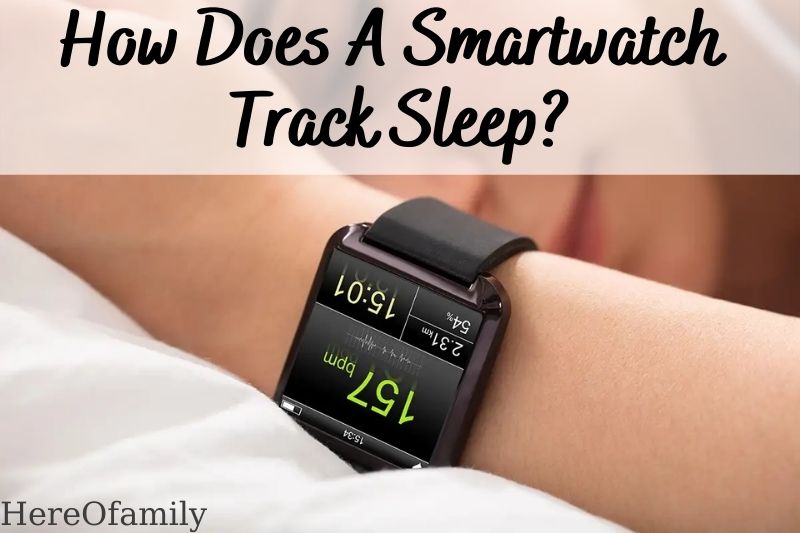- No Voice
A smartwatch is a type of wearable computer designed to be worn on the wrist. It typically has a display, sensors, and a processor and can perform various tasks, such as tracking fitness data, displaying notifications, and controlling other devices.
One of the most popular features of a smartwatch is monitoring sleep. In this article, HereOfamily will discuss how does a smartwatch track sleep and what information they provide.
Contents
- 1 What Can Sleep Trackers Tell You About Your Sleep?
- 2 What Does A Typical Sleep Cycle Look Like?
- 3 Identifying Sleep Patterns
- 4 The Science Behind Wearable Sleep Trackers
- 5 Is Wrist Actigraphy Accurate?
- 6 Beyond Actigraphy: Heart Rate And Respiration In Consumer Sleep Trackers
- 7 Sleep Stage Tracking: The Unmeasurable Elephant In The Room
- 8 How To Get More Restful Sleep
- 9 Conclusion
What Can Sleep Trackers Tell You About Your Sleep?
There are many different types of sleep trackers on the market, and more are being released. Many of them are wearable trackers that may be attached to your wrist. Others attach to your pillow or rest on the nightstand.
These devices have a variety of capabilities, but some of the most frequent ones are:
- Sleep duration: The devices can measure when you fall asleep at night and when you get up in the morning by tracking your inactive time.
- Sleep quality: Trackers can identify disturbed sleep and alert you if you’re tossing and turning or waking up in the middle of the night.
- Sleep phases: Some tracking systems keep track of your sleep phases and set your alarm to go off when you’re sleeping shallower. That should theoretically make it easier for you to rouse.
- Environmental variables: Some gadgets monitor ecological parameters in your bedrooms, such as the quantity of light or temperature.
- Lifestyle factors: Some sleep trackers ask you to enter information about activities that can affect sleep, such as how much caffeine you’ve had, when you last ate, and whether you’re stressed.
![]()
What Does A Typical Sleep Cycle Look Like?
You cycle through numerous stages of sleep over an average night:
- Stage 1: The first stage of sleep is light and straightforward to wake up from, lasting only a few minutes.
- Stage 2: Your brain waves begin to slow during this stage, which is also pretty light.
- Stages 3 and 4: At this point, you’ve progressed to a deeper set of sleep that’s more difficult to wake up from. This is the time of year when your body grows, restores itself, and strengthens your immune system.
- Rapid eye movement (REM): Your brain gets more active, and dreams arise during the final stage of the sleep cycle. Your brain is storing long-term memories and processing information.
Every 90 to 110 minutes, the cycle repeats. The length of REM episodes increases as sleep continues.
Identifying Sleep Patterns
While sleep trackers can collect a lot of data about your sleeping habits, Alan Schwartz, M.D., head of the Sleep Disorders Center at Johns Hopkins Bayview Medical Center, says there’s one thing they don’t do: “They don’t assess sleep directly.”
Instead, he argues, people frequently use inactivity as a proxy for measuring sleep. “Most sleep trackers make some educated guesses about how much you’re sleeping.”
A medical sleep study, which analyzes brain waves to assess the stages of sleep you cycle through during the night, would be required to obtain precise information on your sleeping habits. Such research can aid in diagnosing sleep apnea and other sleep disorders.
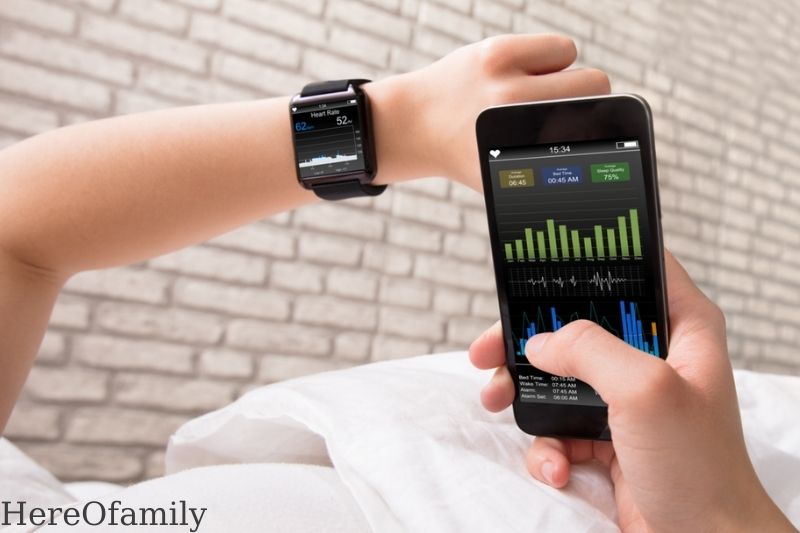
Still, according to Schwartz, tracking devices might help identify patterns in your sleeping habits. Do you feel tired when you sleep from 10 p.m. to 6 a.m. yet energized from 11 p.m. to 7 a.m.? Do you sleep better in a more comfortable room or on days when you exercise? Is it true that consuming caffeine after midday disrupts your sleep?
“The tracker will offer you something to think about,” Schwartz adds, frequently in user-friendly graphs or reports that make spotting trends simple.
It’s a good idea to consult a doctor if you’re concerned about the quality of your sleep. Tracking devices might be a good option if you’re generally healthy and only want to learn more about your sleep habits. “Take the figures with a grain of salt,” adds Schwartz.
If you are considering whether are smartwatches worth buying, see this guide to make the best decision.
The Science Behind Wearable Sleep Trackers
Actigraphy is one of the significant measuring technologies used by wearable sleep monitors. Actigraphy is the process of recording movement using a device called an accelerometer.
The theory is that a certain degree of movement signals that you’re awake, while times of stillness suggest that you’re sleeping.
According to Fitbit’s help page:
Your device guesses you’re asleep if you haven’t moved in roughly an hour. Additional information, such as the amount of time your motions are suggestive of sleep behavior (such as rolling over), assists in confirming that you’re sleeping.
Why Actigraphy Can Be Useful?
Sleep physicians have been using actigraphy to measure sleep for decades. Even though polysomnography is the gold standard for sleep assessment, actigraphy is also significant, especially since polysomnography has its own set of problems.
When a patient is connected to many machines and has multiple electrodes placed on their head in a lab rather than their bed, it’s understandable that they won’t sleep well.
![]()
Actigraphy is less expensive than polysomnography. It also allows people to wear a device at home for a week or two, providing a more realistic picture of their sleep than just one or two nights in a clinic.
But how reliable is wrist actigraphy, and what can it tell you about your sleeping habits?
Fortunately, those two topics have sparked a lot of research.
Is Wrist Actigraphy Accurate?
Martin and Hakim released a fascinating study on the utility of clinical wrist actigraphy in 2011. They also looked at how actigraphy compared to other sleep assessment methods, such as:
- Sleep surveys and clinical interviews
- Sleep journals daily.
- Polysomnography in the lab.
- In children, polysomnography is used.
They claim that wrist actigraphy can assess sleep in a natural context rather than in a lab setting. They do, however, caution against entirely depending on it:
Although actigraphy should not be used in place of clinical interviews, sleep diaries, or overnight polysomnography when clinically indicated, it can offer helpful information regarding sleep in the natural sleep environment and when additional monitoring is required.
They say that wrist actigraphy is reliable in estimating data like total time asleep, sleep percentage, and how long after sleep-waking happens.
The most significant constraint, they say, is confusion between being awake and still being asleep. This could make it more challenging for people who wake up frequently or have chronic insomnia and prefer to stay in bed awake rather than move around.
According to customers, this is also one of the significant issues with commercial sleep trackers. Many complaints can be found in internet consumer evaluations, for example, that time spent lying in bed watching television or reading a book was logged as sleeping.
Comparing Two Types Of Assessment
Researchers in the United States investigated the accuracy of wrist actigraphy against polysomnography in 2013. They discovered results that were remarkably comparable to those found in the 2011 study:
…we conclude that wrist actigraphy, using current methods, helps estimate sleep duration and wakefulness following sleep onset at the individual level.
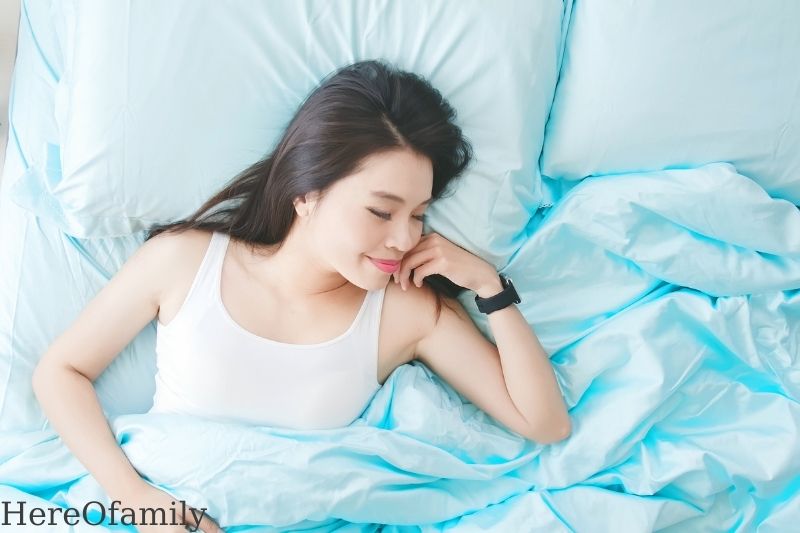
They also suggest that the results of actigraphy could be used to provide people with an objective measure of their sleep, particularly when they are undergoing treatment for insomnia. Given that many people underestimate how long they sleep, this could assist them in recognizing that the treatment is indeed beneficial.
The Limitations Of Actigraphy
Sleep trackers operate better when you sleep pretty well, as I’ve observed in numerous internet publications when the writer has contacted sleep experts.
Errors become more apparent when you have a restless night’s sleep. And it appears that this isn’t just the opinion of sleep lab operators who are doubtful – there’s evidence to back it up.
When you sleep pretty well, sleep trackers work better. Errors become more apparent when you have a restless night’s sleep.
- Study 1
Terri Blackwell compared actigraphy to polysomnography in older women in a 2008 study. She warns that the less sleep you get, the less accurate your sleep tracking will be. Actigraphy, on the other hand, she discovered to be relatively precise for individuals to utilize in their homes:
Actigraphy does not replace polysomnography in sleep assessment, but in sizeable epidemiologic research of older women, it was a practical, inexpensive, and accurate means of collecting sleep measures…
In this sample, sleep characteristics from actigraphy matched PSG reasonably well…
Those with poor sleep quality had the most significant measurement error between the two techniques.
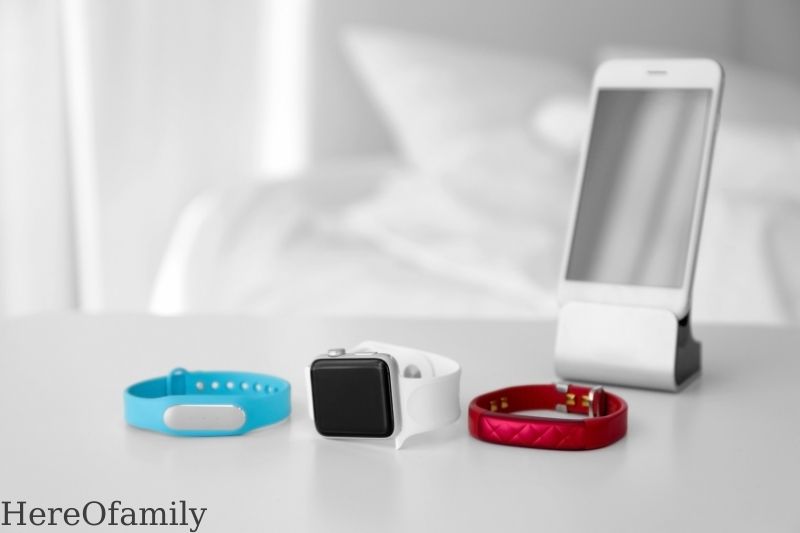
- Study 2
In 2018, a group of Korean researchers compared the sleep diaries of 78 participants with the results of several sleep trackers throughout 14 nights:
- GT9X Link by ActiGraph
- Armband SenseWear Mini
- Fitbit Charge HR Basis Peak
- UP3 (Jawbone)
- Vivosmart by Garmin
Even if some of these are no longer in production or have been discontinued, the following conclusions are nevertheless interesting:
When compared to a sleep diary in a healthy adult population in a free-living scenario, we discovered that the SenseWear, Fitbit Charge HR, Jawbone UP3, and Garmin Vivosmart could be valid measurements of TST (Total Sleep Time) and TIB (Time In Bed).
However, these trackers can’t be trusted when it comes to waking up throughout the night… According to our research, discrepancies between reported variables were also higher during nights with more interrupted sleep (i.e., the sleep diary reported seven h of sleep, and each band would say between 2 and 7 h of sleep for that night).
As a result, it appears that, while wrist actigraphy can be practical for some measurements, it struggles in others. And, sadly, it seems that they have the most difficulty when you aren’t sleeping well, which is when many people might benefit from some precision!
Manufacturers Are Aware Of The Problem
Sleep tracker manufacturers are well aware of these limitations. As a result, some gadgets let you override the automatic sleep tracking, either to specify when you’re trying to sleep rather than rest in bed or fix mistakes in the morning.
But your trust in your gadget will erode if you have to continue doing this.
Beyond Actigraphy: Heart Rate And Respiration In Consumer Sleep Trackers
Actigraphy was all there was when I first started reviewing sleep trackers. However, some now use other variables such as heart rate, heart rate variability, and respiration to improve their sleep calculations.
To make things even more confusing, sleep trackers appear to have split into two main categories, each of which has subtypes (as I refer to them):
- Wearables are devices that are worn on the wrist and can be used as activity trackers or smartwatches. Some of the most modern gadgets are worn on the head.
- Non-wearables: Ballistocardiography measuring strips that sit beneath your mattress and track slight movements created while your heart pumps blood and you breathe. Alternatively, you may use a device that sits on your nightstand and monitors respiration, activity, light, and noise. There are a couple that clip onto a cushion. Certain smartphone apps also attempt sleep tracking.
![]()
When I tried the BeautyRest and Emfit QS side by side in 2018, I had them both under my mattress simultaneously.
Returning to the Fitbit help page, they detail how they ‘guess’ sleep stages.
And this is crucial: sleep trackers don’t precisely measure your sleep; instead, they estimate is based on data collected and algorithms developed by the manufacturer:
Your gadget measures the beat-to-beat changes in your heart rate, known as heart rate variability (HRV), as you move between light sleep, deep sleep, and REM sleep stages while you sleep. When you sync your device in the morning, we estimate your sleep cycles from the previous night based on your movement and heart rate patterns.
Sleep Stage Tracking: The Unmeasurable Elephant In The Room
Estimating your sleep using a combination of actigraphy, heart rate, or breathing is fantastic (when it works), and I have a sense that as technology advances, it will only get better.
However, new measuring equipment brought a colossal elephant into the room: sleep stages.
It’s not for me to say if sleep tracker makers determined around the same time that the technology was good enough to provide consumers with sleep stage data or whether they were concerned about losing sales if they didn’t give what competitors did.
However, unless you have access to a sleep lab and brain wave measurement, you cannot know if your sleep stage data is reliable.
As a result, some customers are unconcerned and trust how their expensive new item works, while others have misgivings but no method of confirming them.
Neither of these options is ideal.
Researchers In The Field Of Sleep Compare Sleep Trackers To Polysomnograms
Many people, I’m sure, would like to know the size of the elephant in the room, but we don’t have any elephant measuring tools. And there’s no regulatory body that oversees sleep trackers assist us.
However, in recent years, sleep researchers have compared sleep trackers to polysomnograms, EEG, and sleep diaries.
The issue, in my opinion, is that manufacturers produce new models or firmware updates regularly. As a result, most published research focuses on sleep trackers that are either older devices or entire brands that have been phased out (such as Jawbone).
How To Get More Restful Sleep
- Avoiding caffeine, your phone or laptop, and big meals before bed are common ways to improve your sleep. If you’re still having trouble drifting off, here are some extra things to try.
- Even if you had a horrible night’s sleep the night before, stick to your regular sleeping hours. It’s tempting to ‘catch up on sleep,’ but it can throw your schedule off.
- Don’t fall for the urban legend that older people require less sleep. Because of the effects of drugs, medical issues, and daytime sleeping, you may find it challenging to get as much restorative sleep at night as you become older.
However, a whole night’s sleep of seven to nine hours should still be your goal. Sleep deprivation has been linked to the development of dementia. Sleep deprivation symptoms, such as melancholy, fatigue, and forgetfulness, might be misinterpreted as dementia.
- Reduce your alcohol consumption at night. Even though alcohol is a depressant and makes you tired, it increases your chances of waking up before you’ve had enough sleep.
It also prevents REM sleep, so you’ll probably feel foggy when you wake up. As a diuretic, it increases the likelihood of you needing to go to the toilet at night. It can also cause snoring, which isn’t great for someone attempting to sleep peacefully next to you.
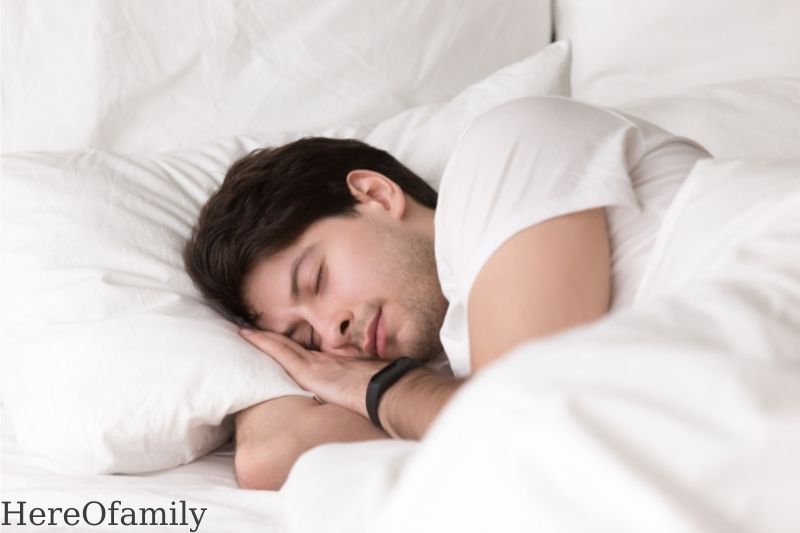
- Also, don’t smoke before going to bed. Smoking may make you feel calmer, but nicotine is a stimulant that makes you more alert. Recognize your rhythm. Some are owls, while others are larks for biological and evolutionary reasons.
If you’re an owl forced to get up early for work, don’t add to your misery by berating yourself if you can’t fall asleep right away.
To reset your body’s circadian clock, try obtaining some sunlight first thing in the morning – for example, having breakfast near a window.
- Make sure you’re at ease. Maintain a dark and chilly environment in your bedroom (18-24°C). Use our mattress evaluations to find a comfortable bed, and check pillows regularly, replacing any that have become lumpy.
Conclusion
A smartwatch is a device used to track the movement of the user’s wrist. It can provide information about how long the person has been awake, how long they have been sleeping, and how many times they woke up during the night.
The watch is essentially a supercomputer on the wrist, which can track your sleep patterns and information about how well you are sleeping. Hope you enjoyed the article!
